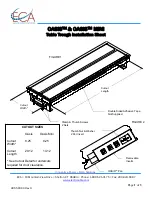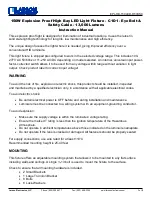
17
Chain Sharpening
m
WARNING!
To ensure that the saw works safely and
efficiently, it is essential that the cutting components are
well-sharpened. It is highly recommended to replace the
chain once it loses its ability to cut cleanly and safely.
It is possible, however, to sharpen the existing chain if the
sharpening is carefully performed. Any work on the chain
and bar requires specific experience and special tools. For
safety purposes, we recommend you contact an authorized
Snow Joe
®
+ Sun Joe
®
dealer or call the Snow Joe
®
+
Sun Joe
®
customer service center at 1-866-SNOWJOE
(1-866-766-9563).
Sharpening is necessary when:
• The sawdust looks like dust;
•
Cutting
becomes more difficult
;
•
The cut is not straight;
•
Vibrations increase.
An authorized service center will sharpen the chain using the
right tools to ensure minimum removal of material and even
sharpness on all the cutting edges.
If you sharpen the chain yourself, use special round-section
files with the right diameter depending on the type of chain
(see “Chain Maintenance Table” on pg. 17). You need a certain
amount of skill and experience to avoid damaging the cutting
edges.
Sharpen the chain as follows (Fig. 29):
• Secure the bar firmly, with the chain mounted, in a
suitable vise.
•
Tighten the chain if it is loose.
• Mount the file in the guide and then insert it in the tooth at
a constant angle from the cutting edge.
•
Sharpen in a forward motion a few times and repeat this
on all the cutting edges facing the same way (right or left).
• To move the chain forward, use a screwdriver.
•
Turn the bar over in the vise and repeat on all the other
cutting edges.
•
Check that the depth limiter tooth does not stick out
farther than the inspection tool
and file any projecting
parts with a flat file, rounding off the edges (Fig.
29).
• After sharpening, remove all traces of filing and dust
and lubricate the chain in an oil bath. Replace the chain
whenever:
– The length of the cutting edges decreases to 5 mm
or less;
– There is too much play between the links and the rivets.
Guide Bar Maintenance
When the guide bar shows signs of wear, turn it over on the
saw to distribute the wear for maximum bar life. Feathering or
burring of the bar rails is a normal process of bar wear. You
should smooth such faults with a file as soon as they occur.
Fig. 29
Inspection tool
Depth limiter tooth
Cutting edge
Depth
limiter
tooth
Chain Maintenance Table
33
3/8
inches
mm
Drive Links
Chain Pitch
Chain Gauge
File Diameter
inches
mm
inches
mm
9.5
0.050
1.3
4
5/32
Summary of Contents for sunjoe GTS4001C-BLK-RM
Page 31: ...30 ...
Page 32: ...sunjoe com ...















































